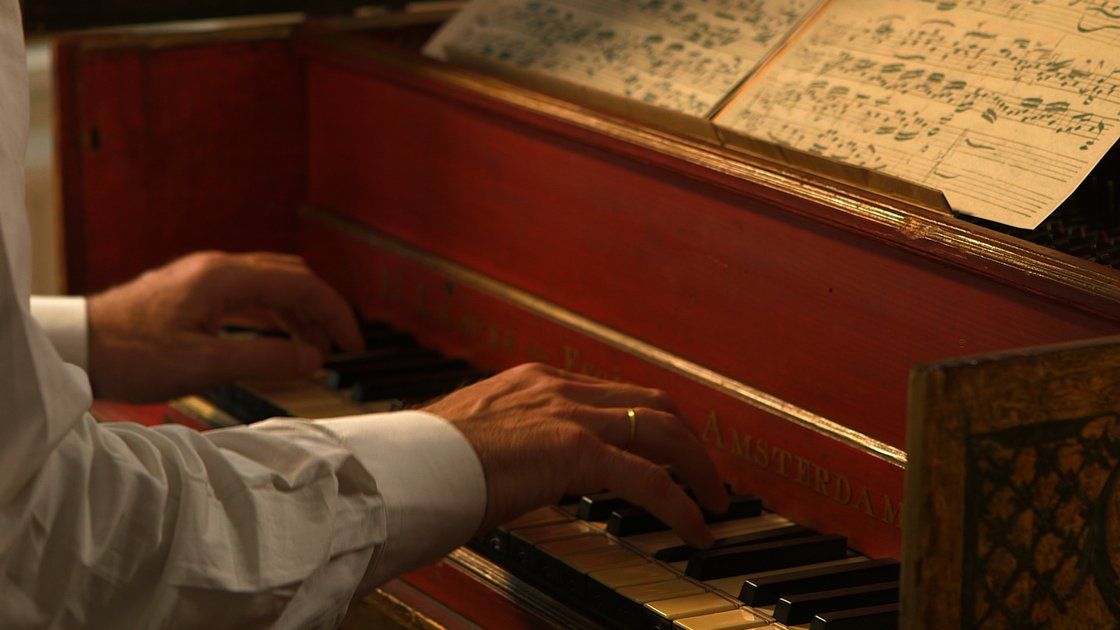Just The Facts, Vol. 3:
Tunings and Temperament
by Jonathan Goldman
 In our last “Just The Facts”, we addressed the fact that the frequency for the keynote of “A” as utilized in orchestras as a means to tune up has varied immensely through the last few hundred years. This has not taken into consideration what the note “A” may have been in millennium before that since there’s really no accurate way to access this. But now we would like to expand this topic into a new realm of consideration that is often overlooked in the much simpler debate about which reference note is best to tune to.
In our last “Just The Facts”, we addressed the fact that the frequency for the keynote of “A” as utilized in orchestras as a means to tune up has varied immensely through the last few hundred years. This has not taken into consideration what the note “A” may have been in millennium before that since there’s really no accurate way to access this. But now we would like to expand this topic into a new realm of consideration that is often overlooked in the much simpler debate about which reference note is best to tune to.
This topic relates to the tunings and temperament of musical scales. Please note that we are taking some tremendously hard and difficult concepts and compressing them into just a few paragraphs. They could easily take up rather large chapters of books, if not become books themselves. In fact, there is a vast literature devoted to the subject of tunings and temperaments. Thus the information below is quite simplified. The goal is to make it as easy to understand as we can, especially for readers who may not be very musically or scientifically knowledgeable about the phenomenon of sound. But this information is very important to take into account, and thus we make it available to you to hopefully inspire some new considerations.
It seems at this time in our understanding of sound as a healing and transformative modality that many are seeking the “Magic Frequency” (this is a concept which involves some healing by numbers note or series of notes that has been established as THE healing key by some advocate of this system). However, from our perspective, equally important is a topic that is most often called tuning or temperament. For those of us involved in the power of sound it’s important to realize that it’s not only the particular frequency of a fundamental tuning note but the relationship of this note to other notes–what’s called an interval. In order to understand this concept, we have to get musical and scientific for just a moment. You’ll realize why in a moment.
In almost every system of music, there something called an “octave”. The “octave” is the basis of music. An octave involves two notes—the second is vibrating twice as fast as the first. And the octave is considered the arrangement of the different notes that are placed between these two notes. If we call the first note “C” and the second note “C”, we have the “do”, “re”, “me” scale that Julie Andrews sang so beautiful in the “Doe A Deer” song from the “Sound of Music”. The notes in this scale are: C,D,E,F,G,A,B,C,. This is the most basic scale in Western Music—it is called a C major scale and represents the white notes on a piano. It’s the scale most children begin with when they start playing.
However, while the name “octave” implies the number “eight”, it actually should be called a “twice as fast” because an octave is really a note that is vibrating twice as fast as the first note. In the scale of C,D,E,F,G,A,B,C, that 2nd “C” is an octave of the first and it is vibrating twice as fast as that first C. Its frequency is double the first.
If you can absorb that information—that an octave is a note that is vibrating twice as first as another note—you are on your way to fantastic understanding of tunings, temperaments and beyond. Why? Because basically, in music, there are multitudinous ways of dividing the distance between the notes in that octave. In the above situation, we gave you a scale of C,D,E,F,G,A,B,C. As stated, these notes make up the white keys of the piano. We didn’t include the black keys (for the sake of creating less confusion), but they are the sharps and flats we find in music. If we take all the black and white keys together, there are twelve notes before the note of the octave occurs.
Regardless, if you’ve got a piano and you looking at those keys, you may be thinking: “So what’s the big deal?” And on one level, if we are only considering pianos at this present moment in time and space that would be correct. But what it’s important to realize that the exact tuning and the intervals between the notes of each piano key have varied significantly over the course of the evolution of harmony in Western music. The most prevalent modern system of tuning is called “equal temperament”. Since the establishment of this system, which has come into almost universal usage only within the last century, the distance between the notes that make up C,D,E,F,G,A,B,C have been pretty much the same. (please note as we covered last month, the exact frequency of each note may be different depending on the initial tuning note, but the distance between the notes is the same). Pianos, and many other Western instruments that have frets and the like, have also been tuned so that the distance between notes is equal. This distance is actually a mathematical formula based upon the distance between each note being the twelfth root of two. Today’s system of equal temperament was the result of centuries of debate between composers, performers, and specialized musicologists. The early evolutions of equal temperament began in the 1700’s, but it was not fully locked in as a universal standard until the 1917 publication of “Modern Piano Tuning and Allied Arts,” written by the acoustical engineer William Braid White. Equal temperament did not simply appear out of the blue and gain instant acceptance overnight!
The reason equal temperament occurred is that before someone came up with the idea of having the distance between the steps on a keyboard be the same (this includes the addition of all the sharps and flats in what is called a “chromatic scale”), it was impossible to play in different keys in a harmonious fashion. Let’s say an organ player in some ancient cathedral would be playing a song in one key. But, if the player switched to another key, there could (or would be) notes in this new key that were really out of tune. In fact, they were sometimes called “howlers” because they sounded like a wounded animal howling. The reason this occurred is too difficult to explain in this article, but please know that such a phenomenon existed. And these “howlers” sounded so bad they were said to have been banned in liturgical music. These notes were certainly one of the reasons that equal temperament tuning was developed. It allowed musicians to play in different keys without danger of hitting sour notes. And it did change the relationship of the notes found in an octave.
With other instruments—especially those in Eastern countries such as India or China—the relationship of the notes C,D,E,F,G,A,B,C to each other can be, and most often are, very different than our equal tempered tuning. I mean, very different. So different, in fact, that someone from India who is used to hearing an instrument using one of the many different tunings of his or her country, would listen to a piano (and other equal tempered instruments) and hear it very much out of tune. Because for these people, the tuning of a piano—this equal temperament—is artificial and not related to the way nature creates sounds. (Incidentally, the opposite also appears to be true—those who have grown up in an environment where equal temperament is the accepted way of listening will hear many of these Indian tunings as being out of tune).
This concept of naturally created sounds, is usually related back to Pythagoras, the ancient Greek philosopher of 600 BC, who is often credited with giving us not only geometry, but also modern music theory. In truth, Pythagoras probably got a lot of his information from the ancient Egyptians. But regardless, he began by taking a string and dividing it in half and seeing what note occurred. As you may (or may not) have guessed—this note that was created was a “twice as fast”, or an octave. Okay. Everything is simple so far. But then, he began doing other divisions of the string, dividing it into thirds, fourths, fifths, etc. He discovered that different ratios (or relationships between different notes) created different sounds. Thus, because of this, he became aware of different tunings. He is said to have created what is known as a “Pythagorean” tuning, which used the largest whole number ratios possible in order to create the division of an octave.
If I keep going, this will get really complicated. Especially, if I bring in the concept of “harmonics”, which are geometric multiples of any sound that naturally manifest. These harmonics can be related to “Pythagorean” tuning and other things that will either fascinate your or totally confuse you, so I’ll just suggest that there if the subject of musical tunings is of interest, goggle it and you’ll find more than you imagine. As noted in the beginning of this writing, I have indeed read books on this subject—it’s something that even today, no one can agree on—which tuning is best.
When I first began in this field of sound healing, I was initially convinced that only those sounds that were harmonically related had true healing power. If this were true it would mean that a piano—regardless of if an “A” was tuned to 430 Hz. or 450 Hz. or anywhere in between—would not have healing ability because it was tuned wrong. It was in equal temperament and not in Pythagorean (or some other) tuning.
In truth, I quickly changed my mind about this, realizing that if this really were the case, then I would have to dismissing all the therapeutic and transformational experiences that people had had by listening to equal tuned music (and that would basically include almost any piece of music created here in the Western World since the time of Bach).
In fact, in the early 1990’s, I wrote an article called “Nine Insights Into Sound Healing”. The title was a bit of a copy of the best-selling book at the time, THE CELESTINE PROPHECIES, which dealt with nine insights. Here is a link to that article: http://healingsounds.com/nine-insights-into-sound-healing
And here is what I wrote about the subject of tuning:
Five: All tunings from different instrument have healing potential.
Many people believe that only harmonically related tunings are healing. Without getting too technical, let me say that the tunings of keyboards are, for the most part, tempered tunings. This means that the natural harmonically related intervals and ratios of different notes, when played together, are changed and different. On a piano, the ratios are logarithmically related, not harmonically. They don’t possess the naturally occurring ratios that are a part of the harmonic series. Blame it on Bach, if you like, since he pioneered equal tempered music. It did change the intervals on the keyboard, but it also allowed players to be able to change keys without hitting “bad” notes.
There are those who feel that only music which has harmonically related intervals created either by the voice or by instruments that are not equal tempered have therapeutic value. As the author of a book which focuses on harmonics I understand this belief, though it doesn’t resonate with me as being true. Too many people have received healings, experienced transformations, and generally had wonderful times listening to music that was created by instruments such as the piano which uses equal temperaments. One cannot denigrate these healing experiences by proclaiming that tunings must be harmonically related to be healing.
It’s been at least 20 years since I wrote these words and this article and I must acknowledge that I do not disagree with the information that’s there. My only disappointment is that I did not realize that the author of THE CELESTINE PROPHECIES would return with more and more insights. I think there must be at least a dozen now (several, which probably took up at least one book each). I think it might be time to create an addendum to these insights into Sound Healing, so there might be at least a dozen.
In the meantime, I just wanted to bring to your attention a follow up from last month’s “Just The Facts”—not only that there are many possible frequencies that have defined the note “A”, but in reality, the distance between different notes (and thus the ways of tuning instruments) can also vary immensely. And this is at least as (if not more) important than merely the specific frequency of one starting note.







